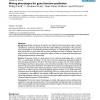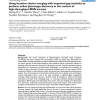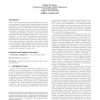BMCBI
2011
13 years 9 months ago
2011
Background: OmniLog™ phenotype microarrays (PMs) have the capability to measure and compare the growth responses of biological samples upon exposure to hundreds of growth condit...
BMCBI
2011
13 years 9 months ago
2011
Background: Caenorhabditis elegans gene-based phenotype information dates back to the 1970’s, beginning with Sydney Brenner and the characterization of behavioral and morphologi...
BMCBI
2008
14 years 2 months ago
2008
Background: Health and disease of organisms are reflected in their phenotypes. Often, a genetic component to a disease is discovered only after clearly defining its phenotype. In ...
BMCBI
2008
14 years 2 months ago
2008
Background: The recent emergence of high-throughput automated image acquisition technologies has forever changed how cell biologists collect and analyze data. Historically, the in...
BMCBI
2010
14 years 2 months ago
2010
Background: Establishing the relationship between an organism's genome sequence and its phenotype is a fundamental challenge that remains largely unsolved. Accurately predict...
BMCBI
2010
14 years 2 months ago
2010
Background: Complex human diseases are often caused by multiple mutations, each of which contributes only a minor effect to the disease phenotype. To study the basis for these com...
BMCBI
2010
14 years 2 months ago
2010
Background: Genome-wide association studies (GWAS) based on single nucleotide polymorphisms (SNPs) revolutionized our perception of the genetic regulation of complex traits and di...
CRV
2005
IEEE
14 years 8 months ago
2005
IEEE
The problem of elucidating the functional significance of genes is a key challenge of modern science. Solving this problem can lead to fundamental advancements across multiple are...
GECCO
2007
Springer
14 years 9 months ago
2007
Springer
The process of development creates a phenotype from one or more genotypes of an individual through interaction with an environment. The opportunity for development to choose a phe...



